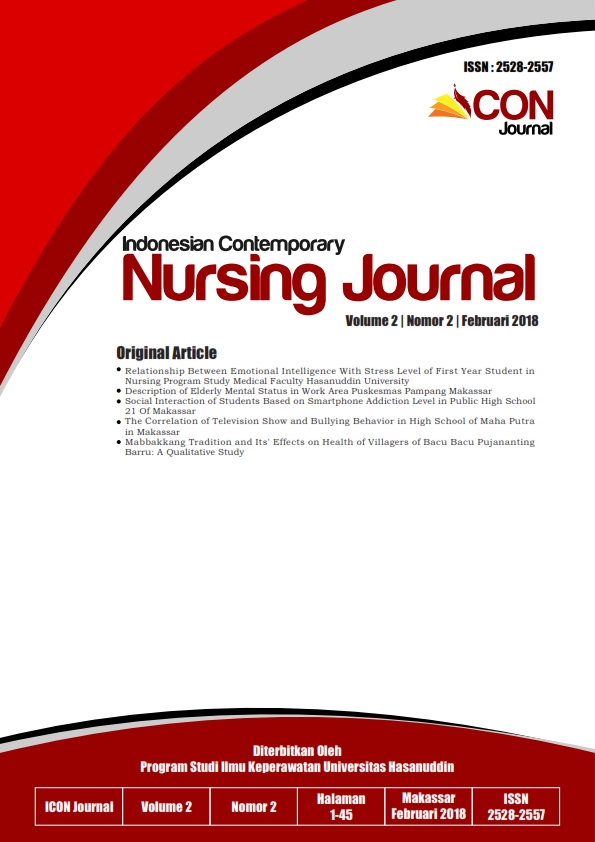Social Interaction of Students Based on Smartphone Addiction Level in Public High School 21 of Makassar
DOI:
https://doi.org/10.20956/icon.v2i2.7808Abstract
Introduction: Smartphone is currently a tool for communications that is widely used by all people, especially among high school students. Excessive use of smartphone can lead to smartphone addiction. Someone who has a smartphone addiction have anti-social behavior towards his environment. This study aimed to describe of social interaction on the male and female students who have a smartphone addiction in SMA Negeri 21 Makassar. Method: This study design used is quantitative with descriptive survey. Selection of sample using cluster random sampling, total 95 respondent. Primary data obtained through questionnaires. Result: Based on the results of a study of 95 respondents, shows that respondents who experienced low-level smartphone addiction 19 people (28.8%) had a high social interaction, similar with respondents who experienced medium-level of smartphone addiction 43 people (65.2%) and high-level 4 people (6.1%) had a high social interaction. Conclusions: The study concluded that all levels of smartphone addiction has a high social interaction, not all respondents who use smartphones tend to be indifferent to his surroundings. They remain more comfortable communicating directly with the people closest. This research is expected can provide benefits that can be used as information specifically for students of SMAN 21 Makassar, and can improve socialization skills in the environment so that it can improve social interaction began to crushedReferences
Ahn, H., Wijaya, M. E., & Esmero, B. C. (2014). A systemic smartphone usage pattern analysis: Focusing on smartphone addiction issue. International Journal of Multimedia and Ubiquitous Engineering (Vol. 9). http://doi.org/10.14257/ijmue.2014.9.6.0 2
Al-Barashdi, H., Bouazza, A., & Jabur, N. (2015). Smartphone Addiction among University Undergraduates: A Literature Review. Journal of Scientific Research and Reports, 4(3), 210–225. http://doi.org/10.9734/JSRR/2015/1224 5
Aljomaa, S. S., Mohammad, M. F., Albursan, I. S., Bakhiet, S. F., & Abduljabbar, A. S. (2016). Smartphone addiction among university students in the light of some variables. Computers in Human Behavior, 61, 155–164. http://doi.org/10.1016/j.chb.2016.03.041
Astiti, D. T. (2013). Meningkatkan kemampuan interaksi social melalui layanan bimbingan kelompok pada siswa program akselerasi SD HJ. Isriati Baiturrahman 01 Semarang. Semarang: Univeristas Negeri Semarang.
Ameliola, S., & Nugraha, H. D. (2013). Perkembangan media informasi dan tekonologi terhadap anak dalam era globalisasi. The 5th International Conference on Indonesian Studies: “Ethnivity and Globalization,” 362–371.
Braun Reseach Inc. (2015). Trends in Consumer Mobility Report. Retrieved from http://newsroom.bankofamerica.com/files/doc_library/additional/2015_BAC_Trends_in_Consumer_Mobility_Report.pdf
Demirici, K., Akgönül, M., & Akpinar, A. (2015). Relationship of smartphone use severity with sleep quality, depression, and anxiety in university students. FULL LENGTH REPORT Journal of B ehavioral Addictions , 85-92.
Haug, S., Castro, R. P., Kwon, M., Filler, A., Kowatsch, T., & Schaub, M. P. (2015). Smartphone use and smartphone addiction among young people in Switzerland. Journal of Behavioral Addictions, 4(4), 299–307. http://doi.org/10.1556/2006.4.2015.037
International data corporation. (2013). Worldwide quarterly mobile phone forecast.
Kwon, M., Lee, J. Y., Won, W. Y., Park, J. W., Min, J. A., Hahn, C., … Kim, D. J. (2013). Development and Validation of a Smartphone Addiction Scale (SAS). PLoSONE, 8(2). http://doi.org/10.1371/journal.pone.0056 936
Lee, H., Ahn, H., Choi, S., & Choi, W. (2014). The SAMS: Smartphone addiction management system and verification. Journal of Medical Systems, 38(1). http://doi.org/10.1007/s10916-013-0001-1
Lenhart, A. (2015). Teens, social media and technology overview 2015: Smartphones facilitate shifts in communication landscape for teens. Pew Research Center, (April), 1–47.
MillwardBrown. (2014). AdReaction Marketing in a Multiscreen World.
Misra, S., Cheng, L., Genevie, J., & Yuan, M. (2016). The iPhone effect the quality of in-person interaction in the precence of mobile device. Environment and Behavior, 48, 275-298
Roberts, J. A., Yaya, L. H. & Manolis, C. (2014). The invisible addiction: Cell-phone activities and addiction among male and female college students. Journal of Behavioral Addictions, 3(4), 254–265.
Saputra, P. (2014). Fenomena Penggunaan Smartphone Di Kalangan Pelajar (Studi Kasus Di SMP Islam Athirah I Makassar). Universitas Hasanuddin.
Santosa, S. 2004. Dinamika Kelompok. Bandung: Bumi Aksara.
Sunaryo. (2004). Psikologi untuk keperawatan. Jakarta: EGC.
Utaminingsih, I. A. (2006). Pengaruh penggunaan ponsel pada remaja terhadap interaksi sosial remaja. Bogor
Downloads
Published
Issue
Section
License
Authors who publish with this journal agree to the following terms:Authors retain copyright and grant the journal right of first publication with the work simultaneously licensed under a Creative Commons Attribution License that allows others to share the work with an acknowledgement of the work's authorship and initial publication in this journal.
Authors are able to enter into separate, additional contractual arrangements for the non-exclusive distribution of the journal's published version of the work (e.g., post it to an institutional repository or publish it in a book), with an acknowledgement of its initial publication in this journal.
Authors are permitted and encouraged to post their work online (e.g., in institutional repositories or on their website) prior to and during the submission process, as it can lead to productive exchanges, as well as earlier and greater citation of published work (See The Effect of Open Access).


